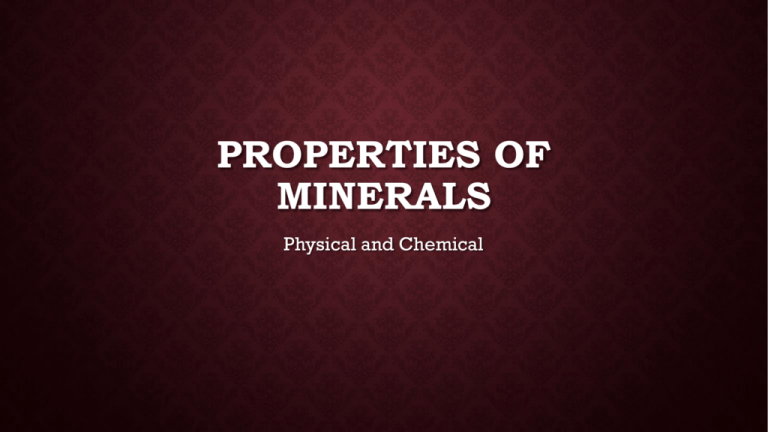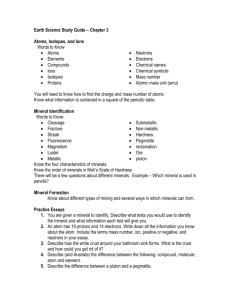Properties of Minerals
advertisement

PROPERTIES OF MINERALS Physical and Chemical CHEMICAL COMPOSITION • Nearly all of Earth’s crust (98.5%) is made up of only eight elements: • • • • • • • • Oxygen Silicon Aluminum Iron Calcium Sodium Potassium Magnesium • All minerals have a specific chemical composition: The mineral silver is composed only of silver atoms, while diamonds are composed only of carbon atoms. • But most minerals are made up of a mixture of different chemical compounds. Each mineral has its own chemical formula. (I.e. Table Salt: NaCl) WHAT ISN’T A MINERAL? • Glass, though made ultimately of sand, which is rich in mineral quartz, is not a mineral. It is not crystalline. Glass has, instead, a very random assemblage of molecules. • Steel is made by mixing different metal minerals like iron, cobalt, chromium, vanadium, and molybdenum. But steel is not a mineral because it is forged by humans and therefore not naturally occurring. • However, almost any rock you pick up is composed of minerals. WHAT PROPERTIES ARE USED TO IDENTIFY MINERALS? • Scientists have identified more than 4,000 minerals in Earth’s crust. Most minerals can be identified with little more than the naked eye and a few tests. • We do this by examining the physical properties of he mineral in question, which include: • Color: the color of the mineral • Streak: the color of the mineral’s powder (this is often different from the color of the whole mineral) • Luster: shininess • Density: mass per volume, typically reported in “specific gravity,” which is the density relative to water. • Breakage: how a mineral breaks • Cleavage: the mineral’s tendency to break along planes of weakness • Fracture: the pattern in which a mineral breaks • Hardness: what minerals it can scratch and what minerals can scratch it






